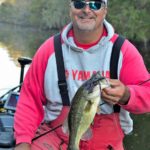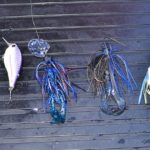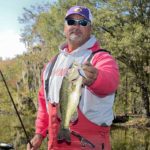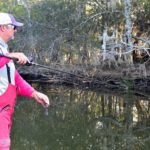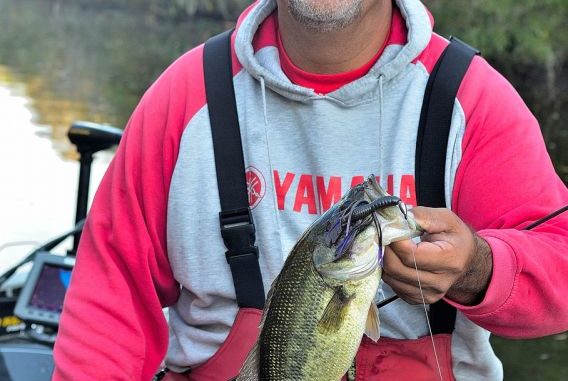
The Lake Verret system warms up early, ushering in spawning activity by the areas bass. Learn how this veteran tournament angler methodically works these waters to build heavy stringers.
Activity at Doiron’s Landing in Stephensville picks up this month, with bass anglers looking to cash in while fish have moved up to spawn.
And 2015 Louisiana State B.A.S.S. Federation Nation champion Scott Buxton will be jostling to get his boat launched so he can probe the waters of the Lake Verret system for nesting bass.
“It’s not unusual to find good fish here starting to move shallower even in late January,” the 45-year-old Buxton said. “Last year when scouting for a February tournament, I was flipping a jig into laydowns, cypresses and stumps in Magazille, and caught one weighing 7.94 pounds on my digital scale.
“The quality of bass here is good, with winning bags in tournaments ranging from 14 pounds all the way to above 18 pounds.”
The weights should only get heavier as weather warms.
“In March there’s been a couple of bags weighing 23 and 24 pounds,” Buxton said. “There was even a bag weighing a little over 25 pounds reportedly taken in the Crackerhead.”
The Napoleonville resident knows what it takes to put quality fish in the boat, having lived in Bayou Corne and spent years learning the system that includes Lake Verret and Grassy Lake, along with bayous like Magazille.
While many anglers can’t wait to fish inside the Atchafalaya Basin levees, Buxton said the Verret system offers more stability during the spring, when high, muddy waters can make the bite inside the Spillway tough.
“I find the waters of the east side of the spillway from Lake Verret south to be better and more consistent in February and in March,” the angler said.
Here is Buxton’s tried-and-true approach to catching bass and winning tournaments in this picturesque swamp:
Outside working in
Buxton has developed a method gained from years of experience in working lakes, bayous and dead-end canals in this system.
“For prestaging fish, I will usually start from the outside in main-lake areas, focusing on points where they meet dead-end canals,” he said.
He said he has taken bass in depths as shallow as 3½ feet when bass are on those points.
Buxton also fishes cypresses on both sides of Lake Verret and Grassy Lake when bass are both staging and spawning.
Later in the month bass move into dead-end canals to actually spawn.
“In colder weather, I’ll find more bass in the first 200 to 300 yards of a dead-end canal,” Buxton said. “When they start getting on beds later, spawning fish can be taken along the full length of the canal.”
The angler explained that sight-fishing bedding bass is a rarity in these waters because of the stained clarity.
“It’s hardly ever clear enough here to see bedding bass,” Buxton said. “It’s certainly not like sight-fishing the clear waters of Toledo Bend.”
In colder weather, especially during the early part of February, he said bites tend to increase after the waters warm up a bit.
“I have had more success catching fish at 10 a.m. and later, since by that time the sun has warmed up the shallows near the trees and laydowns,” Buxton said.
He catches most of his better fish on Texas-rigged crawfish and jigs with crawfish trailers.
Lake Verret
Buxton begins working the west side of Verret because it’s where the sun first hits, warming the waters faster than the eastern shore.
He begins by targeting outlying structure farthest from the banks, working his way shallower by the end of the month.
“I’ll slow-roll spinnerbaits and cast flat-sided square-bill crankbaits to find fish,” Buxton said.
His crankbaits of choice include Lucky Craft’s 1.5 flat-sided model, which he casts when surface waters are below 58 degrees.
“This crankbait gives off a similar vibration as a Rat-L-Trap but with the added advantage of a tight wobbling action,” Buxton explained.
He also uses old Bagley handmade Balsa 8s.
Buxton also employs ¼-ounce, chartreuse-blue-white Cajun Tackle House spinnerbaits, which he slow-rolls around structure.
He uses these crankbaits and spinnerbaits as locator baits only. Once he finds bass, Buxton works the area slowly with a Cajun Tackle House ¼- or 3/8-ounce black-blue Cajun Steamer jig with Tightlines UV-Craw trailers — usually also in black-blue colors.
He also works Texas-rigged black-blue and craw-color Tightlines UV-Craws.
“When I pick up that jig, I’ll usually go back through the area I located fish with spinnerbaits and crankbaits,” Buxton said. “With that jig, I’ll flip it around and within the structure, usually catching bigger fish.”
The angler uses 7½-foot heavy flipping sticks with 20- or 25-pound Seaguar fluorocarbon spooled on Shimano Curados.
For casting and working crankbaits and spinnerbaits, he prefers 7-foot fiberglass cranking rods with the same reels spooled with 14-pound fluorocarbon.
Another location to find quality bass is in the Crackerhead maze of canals located due east across Lake Verret from the Shell Beach area.
“I’ll run across the lake to the Crackerhead, especially if there’s a cold front coming through,” Buxton said. “I’ll fish structure and points in these canals with the same baits.
“Also, depths at 5 to 6 feet in these canals have produced some fine bass for me over the years.”
Magazille, Grassy Lake and Bayou Cheramie
On the way to Grassy Lake, Buxton makes a point to target areas within Magazille Bayou.
“There are two fishable sides of the Magazille, and I’ll pay special attention to the sloughs draining into the bayou,” he said. “I will again target outside structure first, such as trees and stumps, and work to the shallower bank areas.
“In here, the farther the structures come out toward the bayou, the better chances you have of catching quality bass.”
In Magazille, Buxton often casts black-blue ChatterBaits with black-blue Tightline UV-Craw trailers attached to braid.
He also flips structure with Cajun Steamer jigs.
“There are some big stumps and cypress trees, and you want to work the bases of the trees and the cypress knees thoroughly,” Buxton explained. “As for the sloughs, they can really deliver well, especially if the north wind is blowing and the water is draining out on the north side of Magazille.”
In Grassy Lake, Buxton particularly concentrates on finger canals coming out of the swamp all the way to Hog Bayou.
“The north and west ends can deliver excellent fishing in February and March,” he said. “You can work into these fingers unless the north winds move waters out.”
He saw some fine bass taken from this area three years ago — a couple of 10-pounders taken the same day, along with numerous 7s, 8s and 9s.
He works the same locator spinnerbaits and crankbaits here, eventually moving to jigs for better fish.
And he often makes his way down to Bayou Cheramie.
“I’ll run ChatterBaits on the outside bends and jigs on the inside,” Buxton said. “I’ll focus chiefly on these bends along Cheramie for good fish; I won a good tournament in there with a 17-pound bag.
“You want to fish lightly stained waters for the best fishing success.”
